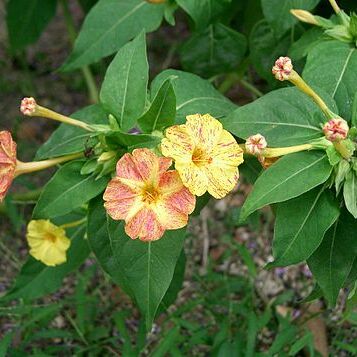Herbs, perennial [annual], often suffrutescent, glabrous or pubescent, sometimes viscid; taproots slender and ropelike to swollen and tuberous. Stems erect to decumbent, unarmed, without glutinous bands on internodes. Leaves petiolate or sessile, ± equal in each pair; blade thin to thick and fleshy, base ± symmetric. Inflorescences terminal and axillary, terminating in pedunculate involucres subtending 1-16 flowers, usually cymose, sometimes consisting of single involucre in leaf axil; bracts persistent, 5, connate or, rarely, distinct, ± ovate, forming weakly to strongly accrescent, herbaceous to papery involucre. Flowers bisexual, chasmogamous and/or cleistogamous; cleistogamous perianth small dome atop basal portion; chasmogamous perianth radially symmetric or slightly bilaterally symmetric, campanulate to funnelform, constricted beyond ovary, tube gradually to abruptly expanded, limb 5-lobed; stamens 3-6, exserted; styles exserted beyond stamens; stigmas capitate. Fruits radially symmetric, with (4-)5 round or angular ribs separated by usually broad sulci, or ribs not well defined or not evident, obovoid, ellipsoid, or nearly globose, smooth or tuberculate, stiffly coriaceous, glabrous or pubescent, without glands.
Herbs annual or perennial. Roots thick, obconic. Leaves opposite, petiolate or upper ones sessile. Inflorescence with each flower surrounded by a 5-fid, calyxlike involucre of bracts, arranged in terminal, ± flat-topped cymes, rarely solitary; involucral lobes erect, acuminate, plicate, not enlarged after flowering. Flowers bisexual, opening in afternoon, fragrant or not. Perianth constricted beyond ovary; limb showy, variously colored, expanded, salverform, plicate, distally 5-lobed, deciduous. Stamens 5 or 6, as long as perianth tube or exserted; filaments adnate to tube at base. Ovary ovoid or ellipsoid. Style linear, as long as stamens or longer, exserted; stigma capitate. Fruit globose or obovoid, coriaceous, crustaceous, or chartaceous, ribbed or tuberculate, without sticky glands. Seed: embryo curved, cotyledons folded, enclosing the mealy endosperm.
Erect herbs, often branched, glandular-pubescent or glabrous; nodes thickened; roots with tubers. Leaves of each pair equal. Inflorescences terminal, corymbose, 1-∞-flowered, each flower sustained by a persistent, accrescent involucre which is divided halfway into 5 oblong, acute lobes. Flowers bisexual, ephemeral, trumpet-shaped, coloured, large, the tube with a constriction above the basal green part; lower portion of tube roundish oblong, ribbed or with knobs; upper portion of tube and limb coloured and circumscissile caducous after anthesis. Stamens 3-6, unequal, distinctly exserted. Ovary (sub)sessile; style distinctly exserted; stigma capitate with short lobes or fimbriate. Anthocarp ribbed or with knobs, not viscid. Seed with bended embryo; cotyledons with recurved margin and surrounding the mealy endosperm.
Herbs with roots often thickened and tuberous, not spiny. Stems ± swollen at nodes. Lvs opposite, petiolate or sessile. Fls ☿, 1-many in ± dense corymbose cymes with very short pedicels; bracts united into a 4-5-lobed calyx-like involucre, sometimes enlarged at fruiting. Perianth most colours except blue; tube elongated, constricted just above ovary; limb spreading, salverform to campanulate. Stamens 3-5-(8), free or connate at base, unequal, = perianth or exserted. Ovary subsessile; style long, filiform; stigma capitate or very shortly lobed, exserted. Anthocarp terete to 5-angled, hard, not viscid, adherent to testa of seed and ± invested in persistent bracts.
Herbs, sometimes shrublike, erect, branched, glabrous or glandular-hairy; roots fleshy. Leaves opposite, in equal pairs at nodes. Inflorescence a terminal, leafy, corymbose cyme, with 1–many flowers. Flowers showy, ephemeral, bisexual, subtended by a deeply 5-lobed, calyx-like, enlarging involucre of bracts. Perianth trumpet-shaped, brightly coloured, constricted above basal green region. Stamens 3–6, exserted; filaments unequal. Style exserted; stigma shortly lobed or fimbriate; ovary sessile. Fruit ribbed or tuberculate, not sticky-glandular, partially enclosed in involucre. Seed 1.
Cal corolloid, funnelform, ± 5-lobed; stamens 3–5; stigma capitate; anthocarp indurated, 5-angled or-ribbed; involucre well developed, 5-lobed, subtending 1–5 fls; perennial herbs (sometimes woody at the base) with opposite lvs and terminal, cymose infls. 60, New World.
Perianth variable in form but often tubular with expanded 5-lobed limb, lower portion constricted above ovary, persistent in fruit, upper portion petaloid, coloured, caducous after anthesis.
Ovary sessile or subsessile, 1-ovulate; style long exserted; stigma globose, usually with densely packed papillae or fimbriate.
Anthocarp ellipsoid, globose or claviform, often angled or ribbed, smooth or tuberculate.
Erect perennial herbs, tuberous-rooted, much-branched.
Fruit enclosed in hardened perianth base (anthocarp).
Involucre of connate bracts calyx-like, 5-lobed.
Flowers conspicuous, hermaphrodite, ephemeral.
Inflorescences cymose, 1-many flowered.
Stamens 3–6, unequal, usually exserted.
Leaves opposite.


